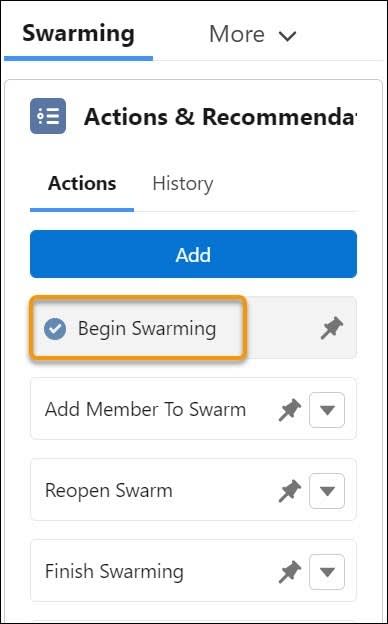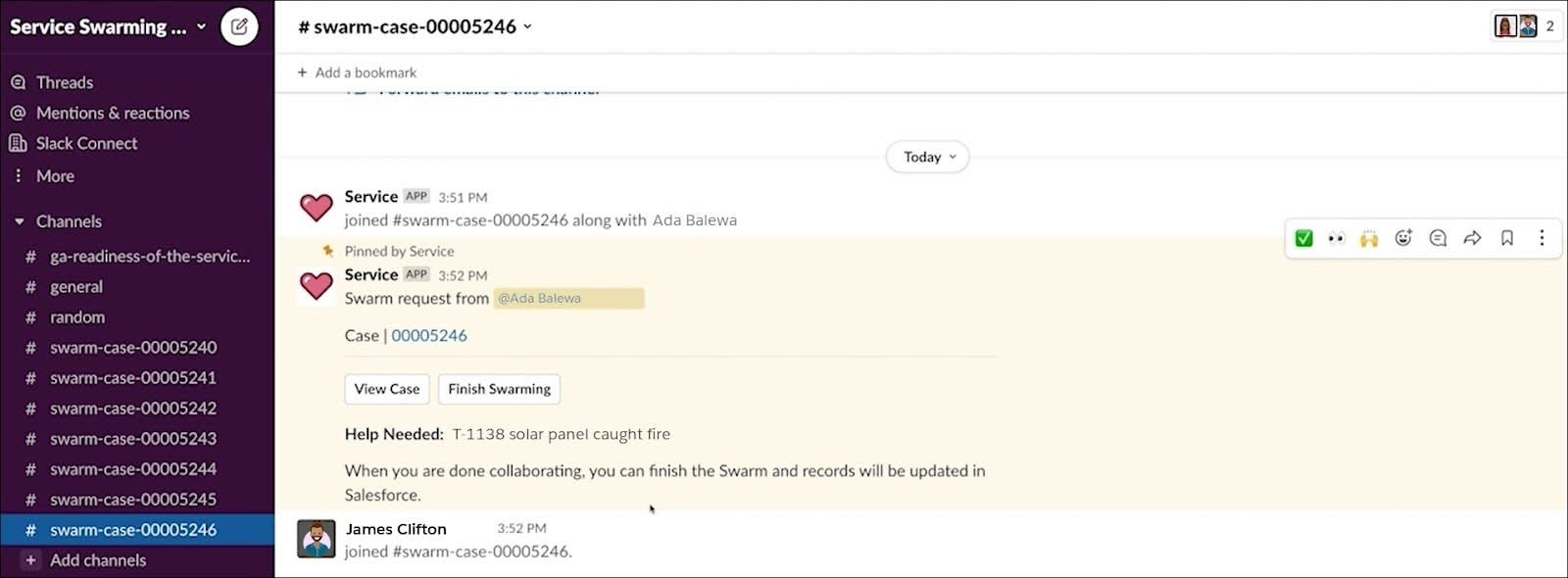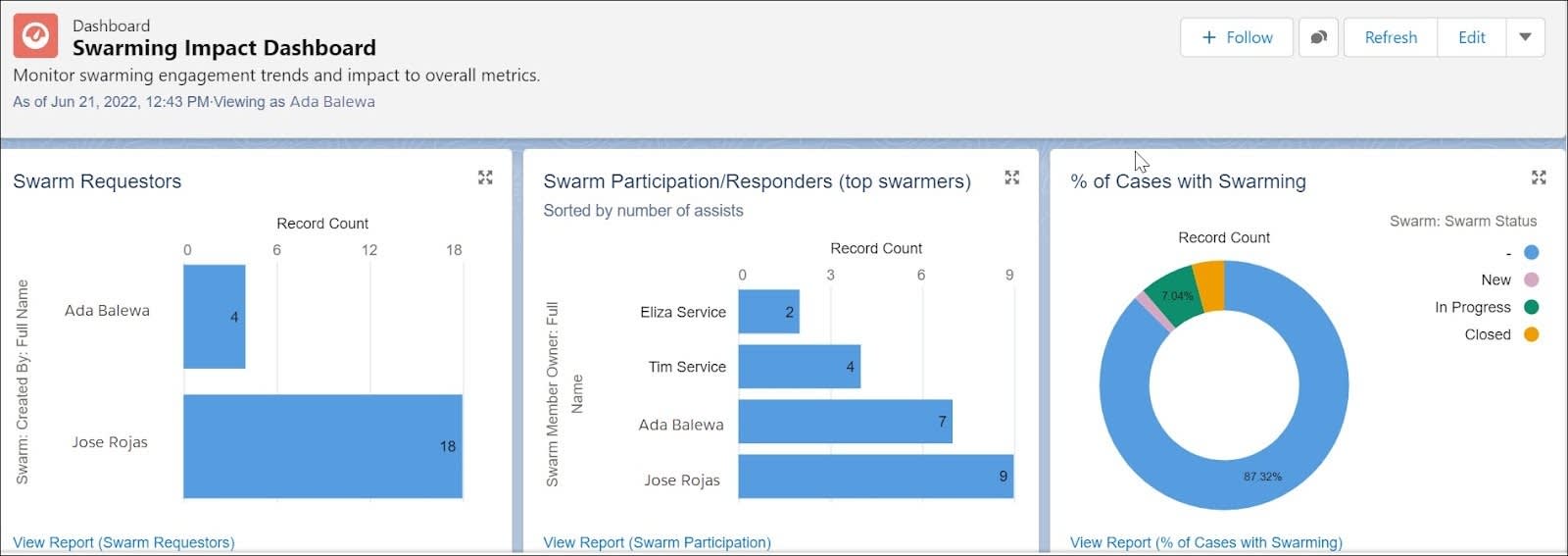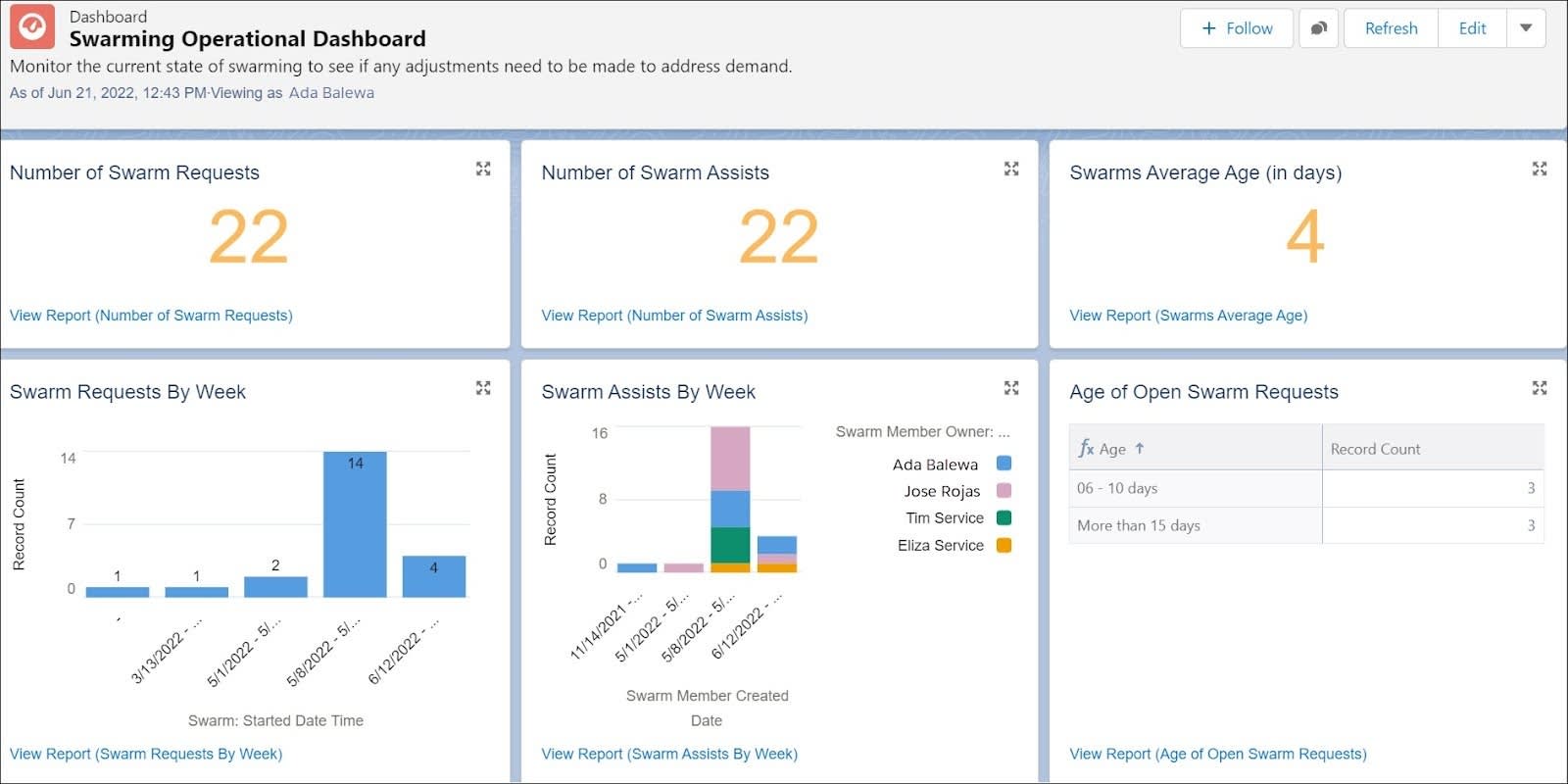Managing a Swarm
Learning Objectives
After completing this unit, you’ll be able to:
- Create a swarm from a case.
- Find experts for your swarm team.
- Start a huddle within Slack.
- Finish a swarm.
- View swarm reports.
An Unusual Case Arrives
Ada Balewa, an experienced agent at Ursa Major, takes a call from a building manager named Chris Templey. His company, Green Fields Media, recently installed Ursa Major’s commercial solar system. Everything was working fine until suddenly one of the T-1138 solar panels caught fire. He wants to get it fixed as soon as possible and then make sure that it never happens again.
Ada has handled many cases, and she’s never heard of a solar panel catching fire before. After making sure that Chris has turned off the solar array so no one can get hurt, she works on figuring out what caused the problem.
Start a Swarm from the Case
First, Ada searches for a Knowledge article to help Chris, but she isn’t surprised to find that there isn’t one. This kind of problem hasn’t happened before at Ursa Major. She’s going to need expert help to figure out what caused this problem.
She starts up a swarm from Chris’s case. She could also start a swarm from Slack, but that’s not where she is right now.
First, Ada needs to decide if she’ll swarm in an existing channel or create a channel. If she already has an existing channel with the right experts in it to solve this problem, she could start the swarm in that channel because everything is ready to go. But she doesn’t have a channel like that for this problem. The T-1138 panels have been in service for a while. Usually the team deals with known problems and doesn’t need to create a swarm.
She needs a new channel where she can pull together people with T-1138 expertise and the account manager for Green Fields Media.
- From the case record or the Slack channel, click Begin Swarming.

- Select the workspace and channel and click Next.
- Ada selects the Ursa Major Solar workspace.
- She creates a channel for this case swarm and selects New Channel.
- Set up the swarm channel and click Next.
- Name the swarm channel. Ada uses the case number:
swarm-case-00005246 - Enter the case owner. By default, that’s Ada and she leaves it as is.
- Make the channel public or private. Ada leaves it as public.
- Enter the help you need. Ada enters:
T-1138 solar panel fire risk
- Set up your swarm team.
- Describe the help you need from your teammates. Ada enters:
Info about why a T-1138 solar panel would catch fire - Choose how to add members to the swarm. Ada chooses Expert Finder because she wants to work with the expert on T-1138 solar panels. Under Skills, she selects Solar Panels, English, and Commercial Installers.
- If needed, add additional members by selecting Add another swarm member. Ada selects Add a specific team member. Then she adds Chris Templey’s account manager to make sure that Ursa Major stays in compliance with the customer service contract as they solve this case.
- Click Next with the Add another swarm member checkbox blank to finish adding members.
Service Cloud adds the customer’s account manager to the swarm. For the Expert Finder member, Omni-Channel routes an invitation to the best available user with the specified skills. That expert receives a swarm member request that they can accept or decline. In this case, that expert is James Clifton. He accepts the request and is automatically added to the swarm.
Back on the swarming panel of the case record page, Ada views the swarm and swarm members. She sees that the account manager and T-1138 expert James Clifton have both joined the swarm.
Solve the Problem and Finish the Swarm
Ada heads over to the newly created #swarm-case-00005246 Slack channel. Her swarm includes Ada herself, the account manager, and James Clifton.

In the first post, Ada sees where swarm members can view the case details right in Slack to understand the problem. James announces that he’s read the case record and suggests a huddle with Ada and Chris from Green Fields Media so they can talk about the problem live.
Because Ursa Major uses Slack Connect, Ada can add Chris to the channel. After a person is added to the channel, they see all the posts. In some cases, it makes sense to have two separate swarms: one for internal-only discussions and one for the swarm team and the customer. Ada decides to bring Chris in right away and gets admin approval.
Then, Ada starts the huddle.
- In Slack, Ada selects #swarm-case-00005246.
- At the bottom of the left navigation column, Ada clicks the headset icon.
James and Chris join Ada on the huddle. James says that he’s heard of T-1138s catching fire, but it’s rare. It only happens about 0.01 percent of the time. He asks if anyone has been up on the roof and Chris mentions that there was a company party up there recently. James suspects that something got bumped or damaged and sets up an emergency appointment to find and replace the damaged panel and thoroughly check the whole system.
Ada writes up a Knowledge article. Now other agents will be prepared the next time a call like this comes in.
Ada hears that the emergency visit was a success and the problem was fixed. She sends that information back to the case record.
- From the Slack channel, hover over the message where the resolution was discussed.
- From the popup, select
 to display more actions and choose Send to Salesforce.
to display more actions and choose Send to Salesforce.
The message appears on the case record with a link back to the Slack channel in case a future agent needs more context.
Now that she’s updated the case record, Ada closes the swarm and the case.
- From the Actions and Recommendations panel in the case record home page or in the Slack post, choose Finish Swarming.
- If anyone else helped, give them credit by adding them to the swarm and click Submit.
Ada only worked with James and the account manager, so she clicks Submit.
- Back on the case record, click Close to close the case.
If the case reopens, Ada can always reopen the swarm from the Slack channel or the case record. For now, she’s glad to have another satisfied customer and moves on to her next case.
Now that Ada has completed a swarm starting from the case record, let’s see what else she can do with the Service Cloud for Slack app. Since Slack gives her some access to Salesforce Service Cloud, she can do a lot using the shortcuts menu.
In Slack, type the following / comments into the messages box to use the shortcuts.
- Enter
/service-searchto enter criteria to search Salesforce records. For example, search for a name to bring up a customer’s contact information, or enter a case number or subject to search for a case.
- Enter
/service-helpto learn about how to use this app.
- Enter
/service-swarm-startto start a new swarm.
- Enter
/service-swarm-closeto close a swarm.
When Ada sees a record, she can open and update it within Slack, so long as she has the right permissions.
Track Swarming Results
Ursa Major Solar has been using swarming for a few weeks now in a pilot program, Ada wants to see how it’s working. She thinks it’s improving case resolution times for hard cases and increasing customer satisfaction, but the numbers can confirm for sure.
Ada can build her own reports on swarms and swarm members, but instead she’d like to use an AppExchange app called Service Cloud Swarming Reports and Dashboards with prebuilt reports. Luckily, her Salesforce admin has already installed it.
Ada opens her dashboards and checks out the Swarming Impact Dashboard.

She and Jose Rojas are the top swarm requestors. She and Jose are often responders, and so are Eliza and Tim Service. She also views the percentage of cases that use swarming. She can drill down into more detailed reports to see more.
Next, she opens the Swarming Operational Dashboard.

The number of swarm requests is low compared to the case volume. This number makes sense because Ursa Major just started swarming. Simple cases are solved using agent experience and Knowledge articles.
She’s happy to see that team members are jumping in to assist whenever they’re asked. The average age of swarmed cases is younger than cases that are escalated using the tiered model.
After reviewing the reports, Ada decides that the swarming pilot is going well. Customers with complex problems are being helped more quickly than before, and team members are collaborating well. She’s ready to roll it out to a larger group of agents.
In this unit, Ada received an unusual case, opened a swarm, and invited in the experts. They quickly solved the customer’s problem and she closed the case and the swarm. Later, she ran swarm reports to see metrics about how swarming is working at Ursa Major Solar.
Resources
- Salesforce Help: Enable Collaboration with Swarming
- Salesforce Help: Swarm in Lightning Experience
- Salesforce Help: Add Members to a Swarm
- Salesforce Help: Close a Swarm
- Salesforce Help: Reopen a Swarm
- Salesforce Help: Create a Swarm Report
- AppExchange: Service Cloud Swarming Reports and Dashboards
